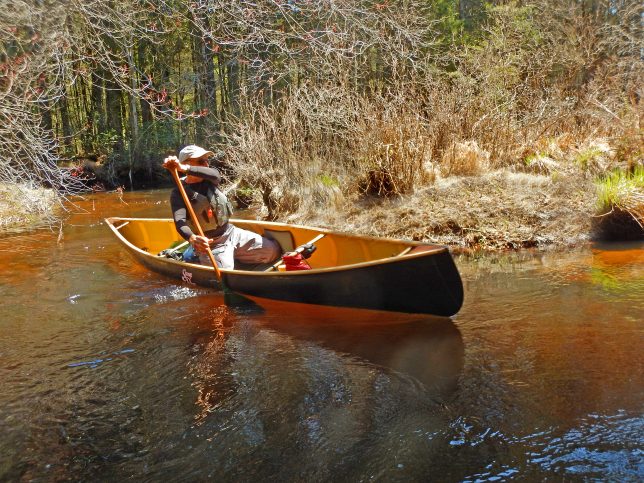
Marc Ornstein
An Initiation to Turning
In Freestyle, we refer to complete turns as “maneuvers”. This is primarily for teaching purposes and for those so inclined, exhibition/competition. Maneuvers consist of three parts – an initiation, a paddle placement and a conclusion. All turns (Freestyle or otherwise) begin with an initiation. In the real world, often the initiation is the only thing necessary to create the desired course change. An initiation can be any force that nudges the canoe in the desired direction. It starts the canoe turning.
Initiations must be clear. They must be unambiguous. Giving the canoe mixed or confusing signals will not result in a clean turn and at best will require additional effort. Let’s look at a couple of examples.
- You want to begin a turn away from the paddle side (toward the off side). You’ve been paddling straight ahead, J stroking to maintain course. Following your last J stroke, you sweep slightly, expecting the canoe to turn. It does not. It continues to go straight or nearly so. Why? You gave the boat mixed signals. The J stroke told the canoe to turn a bit toward the paddle side (at least enough to correct for yaw) while the sweep told it to turn away from the paddle side. The mixed signals resulted in no turn at all or at best a sluggish turn.
- Once again, you want to begin a turn away from the paddle side (toward the off side). You’ve been paddling straight ahead, J stroking to maintain course. This time your last forward stroke, (prior to initiating the turn) is done without a J and is followed by a mild sweep stroke. The canoe easily/gracefully begins turning toward the off side. — Of course, the sweep component could just as well have been added to the last forward stroke. The key was eliminating the J component. Mixed signals are the most common cause of botched or delayed turns and are always a waste of energy.
Initiations should be smooth and more often than not, gentle. Hard, jerky, paddle movements tend to rock or “bobble” the canoe. They create turbulence in the water, both around the hull and the paddle. Bobble and turbulence erode whatever forward momentum has been generated, slowing the canoe and making you work harder.
There are many ways to initiate turns:
Turns to the off side may be initiated with sweeps or uncorrected forward strokes. Heeling the boat to the on side will initiate a turn to the off side. A bit of a bow jam (wedge) will nudge the bow toward the off side. A cross draw would have similar effect. Perhaps there is a bit of a breeze from the on side and you are riding a bit bow light. That breeze may be enough to initiate the turn (as long as you don’t compensate with a J). On streams, especially those with turns and obstacles, one can often take advantage of the varying current to initiate turns.
Turns to the on side may be initiated by simply holding on to the J a bit longer. Heeling the boat to the offside will initiate a turn toward the on side. Try a bit of a bow draw or a C stroke. How about a stern pry or rudder? Then there is the cross wedge. As mentioned above, one can take advantage of river currents or wind.
Once a turn is initiated, the canoe will continue to turn until some opposing force (created by you or mother nature) counters the turn or the canoe runs out of momentum. It is not unusual, under calm conditions for the canoe to turn 90 degrees or more, simply upon an initiation. A good exercise, on a calm lake is to initiate a turn, then take the paddle out of the water, riding the turn until the canoe comes to a stop. If done smoothly, without much boat bobble, the turn will often approach 180 degrees. In the real world, how often do you really need to turn that far?
Turns based solely upon initiations generally slow the canoe only slightly. They don’t steal much momentum-they are efficient. Generally, they allow an easy/smooth transition to the next forward stroke. Using an offside turn as an example, let’s see how several variations play out.
- Initiate with a mild sweep. Once the desired turn has been completed, you simply follow with another forward stroke or J stroke as required.
- Initiate with a slight jam or bow wedge. The paddle is now forward and close to the hull, needing only slight repositioning to be in a perfect catch position for the next forward stroke.
- If you initiate the turn by simply heeling, you may continue on your new course, simply by flattening out the boat, never having missed a stroke.
The list of possible initiations is almost endless. Tinkering/experimenting with initiations can be fun. Try new things. If paddling with a friend, make it a friendly contest. See how many different ways you can initiate a turn.